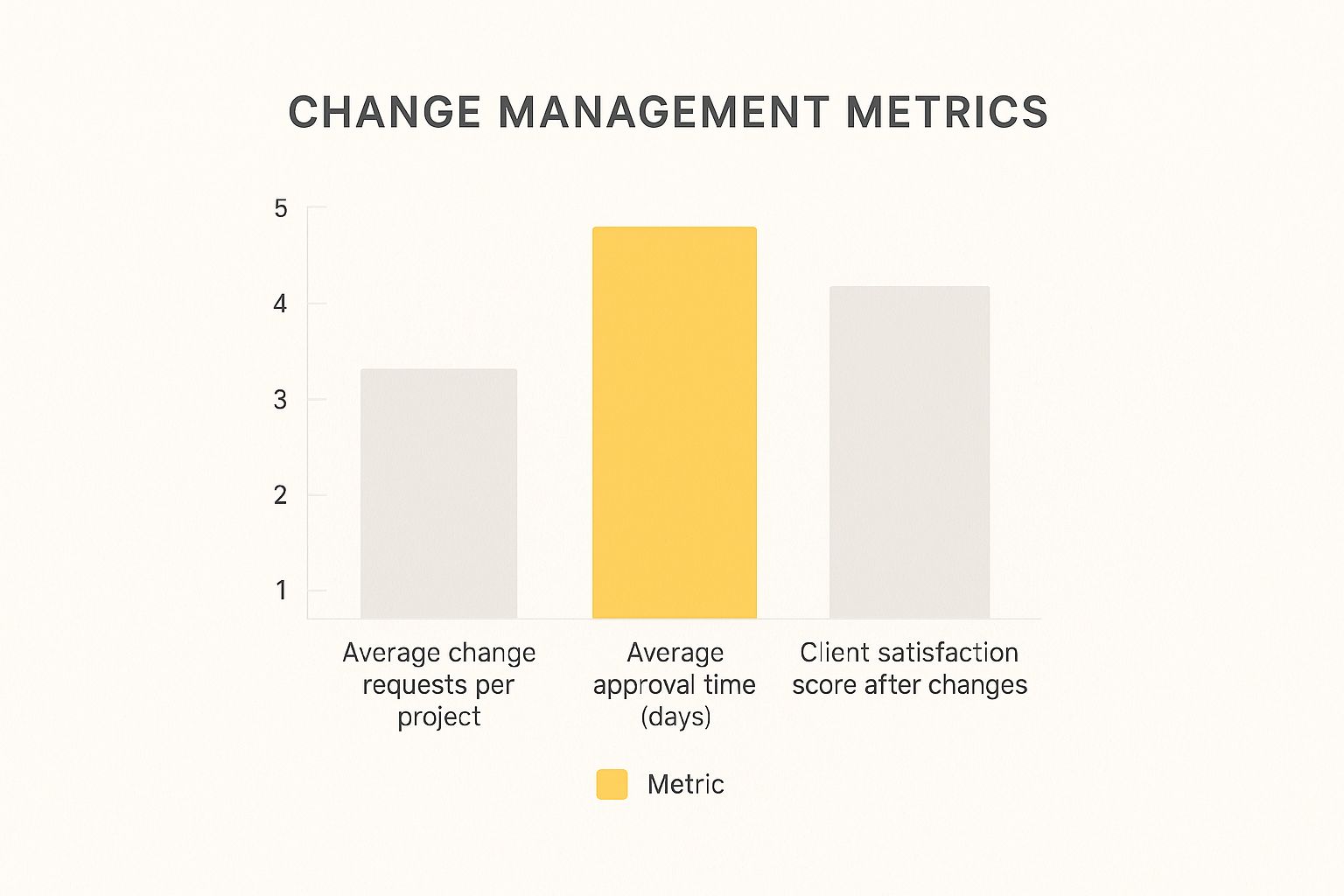The Science Behind Managing Client Expectations
Managing client expectations isn't just about keeping clients happy. It's the foundation of strong, long-term relationships and, ultimately, business success. It's about building trust and transparency in every interaction, from the initial consultation to ongoing service delivery. This trust leads to tangible benefits like better client retention, positive word-of-mouth referrals, and fewer complaints. This proactive approach sets the stage for a mutually beneficial partnership, where businesses thrive and clients feel valued.
Understanding Sector-Specific Expectations
Different industries face unique challenges in managing client expectations. Consider the supermarket industry. Over 50% of Australian shoppers prioritize value for money and fresh produce, shaping their idea of a good shopping experience. This focus has helped budget-friendly chains like Aldi gain popularity by consistently meeting these expectations. Find more detailed statistics here.
The telecommunications sector offers another example. While most Australians report satisfaction with their mobile providers, this sector generates a significant number of complaints to the industry ombudsman. This difference highlights a gap between expected and delivered service.
Financial institutions face a different set of expectations, focused on the security of assets and the quality of financial advice. These factors can heavily influence a client's decision to change providers. These industry-specific nuances underscore the need for individualized approaches to managing client expectations.
The Psychology of Expectation Alignment
Managing client expectations effectively means understanding the psychology involved. The anchoring effect, for instance, describes how the first piece of information we receive shapes our later judgments. A positive initial client experience sets a high bar for future interactions.
However, confirmation bias also comes into play. Clients tend to look for information that confirms their existing beliefs about a business. A negative first impression can be hard to overcome, as clients might focus on aspects that reinforce their negative view. Creating a positive first impression and consistently reinforcing it is essential for long-term success.
Building Trust Through Transparency and Communication
Effective communication is also crucial. It's not just about keeping clients informed. It's about proactively addressing potential problems and setting realistic timelines from the start. This transparency builds trust and minimizes misunderstandings later. For example, if a project is delayed, proactively communicating the issue and suggesting solutions strengthens the client relationship instead of damaging it.
Successfully managing client expectations involves understanding industry-specific needs, using psychological principles, and implementing strong communication strategies. This combined approach creates a positive feedback loop where client satisfaction drives business growth and strengthens competitive advantage in the Australian market.
Establishing Bulletproof Client Expectations From Day One
The foundation of a successful client relationship starts long before the project begins. It's built on clear, proactive communication and a shared understanding of what success looks like. Think of it as building a house: a solid foundation is essential for a stable structure. Similarly, setting clear expectations from the start ensures a smooth, collaborative project.
The Importance of Discovery Sessions
Effective discovery sessions are crucial for understanding client expectations, both the stated ones and those hidden beneath the surface. These sessions allow you to delve deep into the client's needs, goals, and anxieties. When establishing bulletproof client expectations, understanding those needs is key. Consider exploring the concept of a Unified Customer View. This allows you to craft a tailored approach that addresses their explicit requests and anticipates potential pain points.
For example, a client might request a new website, but their underlying need could be to increase online leads. Understanding this deeper need allows you to focus your efforts on deliverables that truly make a difference.
Documenting Agreements and Deliverables
Once you understand the client's vision, documenting the agreement is paramount. This doesn't just mean a formal contract; it also includes outlining specific deliverables and timelines. This documentation serves as a roadmap for the project, preventing scope creep and ensuring everyone is on the same page. This clarity is essential for managing expectations and avoiding misunderstandings.
Crafting Proposals That Align Promises and Capabilities
The proposal stage is where you translate the client’s desires into concrete actions. A well-crafted proposal clearly outlines the scope of work, proposed solutions, and realistic timelines. It’s important to be upfront about your capabilities and avoid overpromising. Setting realistic expectations builds trust and credibility, while overpromising sets the stage for disappointment.
To help you further understand the components of effective client onboarding, take a look at the table below:
This table outlines the essential elements of a client onboarding process that effectively sets expectations from the beginning of the relationship.
| Component | Purpose | Implementation Tips | Common Pitfalls |
|---|---|---|---|
| Discovery Sessions | Uncover client needs and goals | Ask open-ended questions, actively listen, and document everything | Focusing on solutions before understanding the problem, rushing the process |
| Documented Agreements | Formalize the scope of work, deliverables, and timelines | Use clear and concise language, get client sign-off, and store securely | Vague language, missing deadlines, neglecting client review |
| Realistic Proposals | Present feasible solutions and timelines | Be transparent about capabilities and limitations, provide options, and justify costs | Overpromising, underestimating resources, lacking clarity on deliverables |
| Proactive Communication | Identify and address potential issues early on | Schedule regular check-ins, provide progress updates, and be responsive to inquiries | Infrequent communication, ignoring warning signs, reactive problem-solving |
As you can see, each component plays a crucial role in building a strong foundation for the client relationship. By focusing on clear communication, thorough documentation, and proactive problem-solving, you can set the stage for a successful project and a happy client.
Identifying and Addressing Warning Signs
Even with the best planning, mismatched expectations can arise. Recognizing early warning signs, such as hesitant communication or vague feedback, is crucial. Addressing these issues proactively can prevent them from escalating into bigger problems. Think of it like a small crack in a dam – if left unchecked, it can lead to a catastrophic breach. Similarly, addressing small issues early on can prevent significant damage to the client relationship. Regular check-ins and open communication are essential for keeping expectations aligned throughout the project. This proactive approach ensures that any potential issues are identified and addressed promptly, maintaining a strong, collaborative partnership.
Digital Transformation: Reshaping Client Expectations

Technology is changing how clients interact with businesses, influencing their service expectations. This shift requires companies to adapt their approach to managing these evolving needs. It's about understanding the impact of digital tools and observing how successful businesses are responding.
Leveraging Technology to Anticipate Client Needs
Leading companies are using technology like AI, automation, and predictive analytics to anticipate client needs. This proactive strategy goes beyond simply reacting; it's about understanding what clients want before they ask.
Imagine a retail store that knows your typical purchases and alerts you to relevant sales before you even enter. This personalized approach is rapidly becoming standard practice.
Additionally, digital transformation has created a demand for omnichannel experiences. Clients expect seamless interactions, regardless of whether they contact you through your website, social media, or by phone.
For example, using smart voicemail solutions like those from OnSilent can improve communication and ensure clients feel heard, regardless of their chosen channel. This consistent experience builds trust and fosters loyalty.
Balancing Efficiency and Human Connection
While technology offers increased efficiency, the human touch remains crucial. Clients still value personalized interactions. The key is finding the right balance between automated processes and genuine human connection.
This balance is especially important in industries like mortgage broking and real estate, where clients often seek trusted advisors. In Australia, for instance, 80% of customers now value their experience as much as the product itself. This shift has created a new standard, making effective expectation management essential. Find more detailed statistics here.
Aligning Internal Capabilities with Digital Promises
Your internal systems and team capabilities must align with your digital promises. This means ensuring your staff has the tools and training to provide the seamless, personalized service clients expect.
For instance, if you offer 24/7 online support, your team needs the resources to handle inquiries promptly. Failing to deliver on digital promises erodes trust and can lead to client churn.
Furthermore, internal challenges like fragmented systems can hinder your ability to meet client expectations. Consider a client contacting support multiple times for the same issue because information isn't shared effectively internally. This creates frustration and damages the client relationship. Addressing such operational bottlenecks is essential for effective management of client expectations.
Adapting to Evolving Client Needs
Finally, it's important to recognize that client expectations are constantly evolving. Businesses must remain adaptable and adjust their strategies accordingly.
Regularly collecting client feedback and monitoring industry trends are crucial for staying ahead. This continuous improvement ensures your business remains relevant and competitive.
This proactive approach will help you anticipate changes in client needs and adapt your strategies to consistently deliver exceptional experiences. By embracing digital transformation while maintaining a focus on human connection, you can build strong, lasting client relationships that drive business success.
Communication Frameworks That Transform Client Trust

Communication is the foundation of any strong client relationship. It's not just about frequency, but about establishing clear communication channels and frameworks that foster trust and transparency. This involves providing regular updates to minimize uncertainty and selecting the right communication methods for various types of messages. For more insights, check out this helpful article: How to master client communication.
Establishing Communication Rhythms
Just like a consistent fitness routine, a regular communication rhythm is crucial for managing client expectations. Regular updates, even minor ones, keep clients informed and demonstrate your commitment. This prevents anxiety about project progress and builds confidence in your process.
For example, scheduling weekly check-in calls or sending concise progress reports can ensure everyone stays aligned. This consistent communication builds a strong foundation for a successful working relationship.
Choosing the Right Channels
Different messages call for different communication channels. A quick update might be perfect for a simple email, while a major development or sensitive matter requires a phone call or video conference. Using the right channel makes sure your message is received and understood clearly. A smart voicemail solution can also be a valuable asset for efficient client communication, especially for busy clients.
Handling Difficult Conversations
Let's be honest, not every client conversation will be smooth sailing. Timeline shifts, budget adjustments, and scope changes are often part of the process. Addressing these challenges head-on with transparency and a solution-oriented approach, however, can actually strengthen the client relationship.
Proactive problem notification, instead of hiding issues, builds trust. It shows the client you respect the partnership and are committed to finding the best way forward.
Implementing Scalable Communication Systems
As your business grows, your communication systems need to scale with it. Tools like Client Relationship Management (CRM) software can automate tasks like sending updates, tracking progress, and maintaining a centralized communication log. HubSpot is one example of a popular CRM.
This ensures consistency across your organization and frees up your team to focus on building valuable client relationships. Standardized communication procedures also ensure everyone on your team follows best practices, creating a more unified client experience.
Real-World Examples of Effective Communication
Many businesses, especially those with diverse customer bases, understand the value of clear and consistent communication. Supermarkets, for instance, often use targeted email campaigns and loyalty programs to keep customers informed about specials and new products. Banks use a mix of email, SMS, and in-app notifications to update clients about account activity and security measures.
This proactive communication builds trust and fosters customer loyalty. These examples highlight how effective communication isn't just a task, but a strategic investment in building long-term client relationships.
To further illustrate a structured approach to communication, consider the following framework:
Client Communication Framework
A structured approach to client communication across different scenarios and stages of the relationship
| Scenario | Communication Frequency | Recommended Channels | Key Messages to Include |
|---|---|---|---|
| Project Kick-Off | Initial meeting, then weekly | Video conference, email | Project timeline, key milestones, roles and responsibilities |
| Regular Updates | Weekly or bi-weekly | Email, progress reports | Progress summary, upcoming tasks, potential roadblocks |
| Issue/Delay Notification | Immediately | Phone call, email | Clear explanation of the issue, proposed solutions, revised timeline |
| Project Completion | Final meeting, follow-up email | Video conference, email | Project summary, key achievements, next steps |
This framework provides a starting point for tailoring your communication strategy to various client needs and project stages. By consistently applying these principles, you can ensure clear, effective, and trust-building communication throughout the client lifecycle.
This illustrates how proactive, structured communication transforms client trust into a powerful advantage. By implementing these strategies, you can cultivate stronger, more profitable client relationships, leading to greater success for your business.
Breaking Down Operational Barriers to Expectation Delivery
Managing client expectations isn't just about the initial agreement. It's about making sure your internal operations can consistently deliver. This section explores how operational inefficiencies create gaps between promises and actual delivery, ultimately impacting client trust.
Identifying Operational Bottlenecks
Internal obstacles, such as organizational silos, fragmented systems, and resource constraints, often create disconnects that negatively affect client relationships. Imagine a client contacting your business with an issue, only to be transferred between departments because of poor internal communication. This frustrating experience damages client confidence and highlights a significant operational barrier.

The infographic above visualizes data related to change management, showing average change requests per project, average approval time, and client satisfaction scores. Longer approval times correlate with lower client satisfaction, emphasizing the importance of streamlined processes. Building strong relationships starts with trust. Learn more about strategies for building trust with customers.
Addressing Operational Challenges
To avoid these issues, businesses need to proactively identify and address these bottlenecks. This means implementing clear communication channels between departments, integrating systems for seamless information flow, and allocating resources effectively to meet client demands. This is particularly important in the fast-paced Australian market, where clients expect efficient and timely service. Statistical insights reveal the impact of managing client expectations on operations and loyalty. For example, in 2025, 37% of Australian customer service agents cited internal delays and system disconnects as major obstacles to effectively responding to client needs. Discover more insights about Australian customer service trends here.
Cross-Functional Alignment and Knowledge Sharing
Creating a culture of cross-functional alignment is key. Teams should share information and collaborate towards common goals. This collaborative approach minimizes delays and ensures a consistent client experience. This means everyone, from sales to operations, understands client expectations and works together to fulfill them.
Knowledge sharing systems, like centralized databases or internal communication platforms like Slack, facilitate this process. They empower teams to access the information they need to provide efficient and informed service. Consider a scenario where a customer service agent can easily access a client's complete history and preferences. This allows them to offer personalized support and resolve issues quickly.
Service Integration and Maintaining Excellence
Businesses should also strive for service integration. This means ensuring all client-facing services work together smoothly, offering a unified and consistent experience. Integrating CRM systems with communication platforms, for instance, allows for streamlined client interactions across different channels.
Maintaining service excellence during periods of growth or transformation is also essential. As businesses evolve, internal changes shouldn’t negatively impact the client experience. Implementing robust change management processes and providing continuous staff training are crucial for consistent service quality. This lets businesses adapt to changing demands while ensuring clients receive the expected level of service. This consistent delivery builds trust and reinforces client confidence. By addressing these operational barriers, you can build a strong foundation for delivering on promises and developing strong, long-term client relationships.
The Psychology of Managing Client Expectations

Understanding client psychology is key to managing expectations effectively. It involves recognizing the cognitive biases and psychological frameworks that shape client experiences. These principles influence how clients form opinions, interpret interactions, and ultimately remember their time with your business.
Cognitive Biases and Client Perception
The anchoring effect significantly shapes client perception. The first piece of information a client receives often becomes an anchor, influencing later judgments. A positive first impression is vital. A clear, well-structured proposal, for example, can set a positive anchor for the whole project.
Confirmation bias also plays a role. Clients tend to favor information confirming existing beliefs. A negative initial experience can lead them to focus on aspects reinforcing that negativity. Consistent positive interactions are essential for overcoming this bias and building a strong relationship.
The peak-end rule is another key principle. People judge experiences based on the most intense moment and the ending, not the overall average. Creating memorable positive moments and ensuring a positive final interaction significantly boosts client satisfaction.
Strategic Approaches for Managing Psychological Factors
Understanding these nuances allows for strategic expectation management. This includes setting appropriate anchors, framing expectations positively, and creating memorable moments. For more information, check out this resource on effective client communication.
Setting clear, realistic expectations from the start is fundamental. This acts as a positive anchor and minimizes later misunderstandings. Framing expectations positively emphasizes the value and benefits clients receive, not just the tasks involved.
Creating memorable moments at key points, like project milestones, strengthens the overall positive perception. This can be something as simple as a personalized thank you note or a small gift.
Addressing Both Rational and Emotional Factors
By grasping the psychological principles at play, you can develop refined approaches to managing client expectations. These strategies address both the rational and emotional factors influencing perception. This approach builds trust and strengthens relationships, leading to greater success, especially in client-centric industries like mortgage broking or real estate. Focusing on both the rational and emotional aspects cultivates stronger, more sustainable client relationships.
Measuring and Evolving Your Expectation Management
Managing client expectations isn't a fixed process. It's an ongoing journey of evaluation and improvement. Just like a gardener nurturing their plants, you need to consistently monitor, adjust, and cultivate the client relationship to ensure it thrives. This means understanding how to measure your strategies and adapt based on feedback and industry changes.
Implementing Quantitative and Qualitative Metrics
To truly gauge your performance, you need a mix of quantitative and qualitative metrics. Quantitative metrics, like client retention rates and customer satisfaction scores, offer solid data points. Qualitative metrics, like client feedback and testimonials, provide valuable context and insight into actual client experiences. It's like getting a health check-up: you need both concrete numbers (like blood pressure) and subjective information (how you're feeling) for a complete picture.
For example, tracking the number of resolved support tickets (quantitative) alongside client comments about the support process (qualitative) gives you a well-rounded view of your customer service performance.
Developing Feedback Systems
Actively seeking honest feedback is paramount. This might involve simple post-project surveys, regular check-in calls, or using online review platforms like Trustpilot. The key is to make sharing feedback easy and accessible for clients, both positive and negative. These insights highlight your strengths and pinpoint areas for improvement.
Responding to client feedback is crucial, showing clients their opinions matter. Addressing concerns and acting on feedback demonstrates your commitment to a strong relationship.
Service Recovery: Turning Failures into Opportunities
Even the best-laid plans can sometimes go awry. How you handle these situations is key. Service recovery focuses on transforming expectation failures into opportunities to build trust. This might involve a sincere apology, a discount on future services, or going the extra mile to rectify the situation.
This proves to clients that you value their business and are committed to making things right. A well-handled service recovery can often strengthen the client relationship even more than if the issue hadn't occurred at all. You might be interested in: How to master communication etiquette.
Creating an Organization-Wide Approach
Managing client expectations isn’t solely the responsibility of the client-facing team. It needs to be ingrained in the company culture. This involves clear communication across departments, ensuring everyone understands client expectations, and empowering employees to take ownership of client satisfaction.
This organization-wide approach ensures a consistent client experience. Regardless of who a client interacts with, they receive the same high level of service and attention, strengthening the relationship and fostering trust.
The Maturity Model for Expectation Management
A maturity model offers a framework for evaluating your current capabilities and plotting a course towards excellence. This model generally outlines different stages of maturity, from basic reactive approaches to proactive, strategic expectation management.
By assessing your current position, you can identify areas for growth and develop focused strategies to reach higher levels of maturity. This structured approach promotes continuous improvement and creates a sustainable competitive advantage.
Continuously refining your expectation management process ensures you're not just meeting today’s needs, but anticipating and exceeding those of tomorrow. This cultivates lasting client relationships that contribute to long-term success.
Ready to improve client communication and increase satisfaction? Explore how OnSilent's smart voicemail solutions can help you stay organized, manage calls efficiently, and ensure you never miss a vital client interaction. Learn more about OnSilent and how it can benefit your business.

